My Journey to Raw: Carter’s close call.
This post is part of our “Journey to Raw” series, published on Wednesdays, and comes to you from Erica Scott, a devoted cat and dog mom who has always had a soft spot for cats with special needs and shares that passion with her loving spouse. Erica recently uprooted her crew to the Pacific North West where they continue to enjoy and thrive off their fresh and species-appropriate meals!.
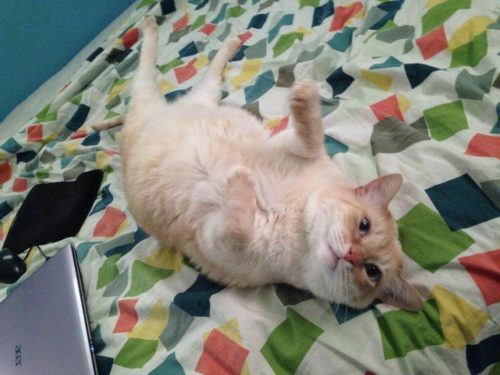 In June 2013 I moved myself and my two male cats down to Alabama from Vancouver, BC to visit and live with and meet my future in-laws for the first time. My spouse and I were setup in the in-laws quarters of the house for our extended stay, which is where I first met Carter, a huge, fluffy cream-ball cat that would purr as soon as you started looking at him. Carter had a permanent cooking pot laying on the floor, filmed to the brim with low-quality kibble. His litter box was never scooped and he was constantly itchy and plagued with fleas. This didn’t sit right with me, and I took it upon myself to ask if I could take care of him (reduce feeding, clean and wash his litter box, etc) within reason while I was staying there. They were indifferent and I was told by my spouse that this had always been the condition of his care; subpar at best. I ended up pursuing my permanent residency in the United States, which required us to live in the in-laws quarters for a little longer than originally anticipated. I asked if we could move Carter into our part so we could take care of him on a more permanent basis while we still lived there, and was granted permission. At this time, I was still feeding my cats kibble as well, but “higher quality” brands such as Nature’s Variety and Acana. Carter adjusted to living with my other two cats pretty quickly, and we began to drastically cut down his food intake. I wanted to take him to the vet, but at the time money was tight and it was a struggle just to care for ourselves and my own cats while waiting to get my work visa; my in-laws did not see the point in shelling out money to take him for an annual exam or blood-work, despite his morbid obesity and allergy problems.
In June 2013 I moved myself and my two male cats down to Alabama from Vancouver, BC to visit and live with and meet my future in-laws for the first time. My spouse and I were setup in the in-laws quarters of the house for our extended stay, which is where I first met Carter, a huge, fluffy cream-ball cat that would purr as soon as you started looking at him. Carter had a permanent cooking pot laying on the floor, filmed to the brim with low-quality kibble. His litter box was never scooped and he was constantly itchy and plagued with fleas. This didn’t sit right with me, and I took it upon myself to ask if I could take care of him (reduce feeding, clean and wash his litter box, etc) within reason while I was staying there. They were indifferent and I was told by my spouse that this had always been the condition of his care; subpar at best. I ended up pursuing my permanent residency in the United States, which required us to live in the in-laws quarters for a little longer than originally anticipated. I asked if we could move Carter into our part so we could take care of him on a more permanent basis while we still lived there, and was granted permission. At this time, I was still feeding my cats kibble as well, but “higher quality” brands such as Nature’s Variety and Acana. Carter adjusted to living with my other two cats pretty quickly, and we began to drastically cut down his food intake. I wanted to take him to the vet, but at the time money was tight and it was a struggle just to care for ourselves and my own cats while waiting to get my work visa; my in-laws did not see the point in shelling out money to take him for an annual exam or blood-work, despite his morbid obesity and allergy problems.
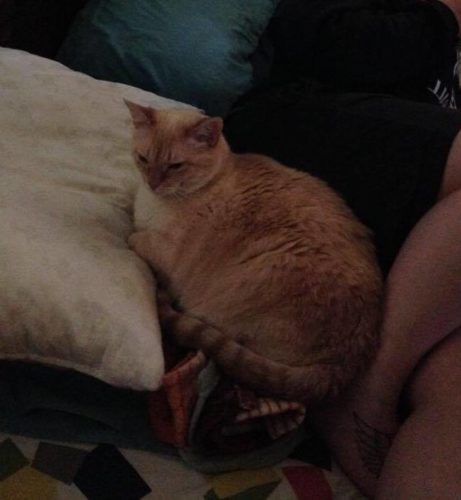 I considered this setup to be more of a “foster” situation, but when it came time to move out, my spouse and I both decided that it would be irresponsible to put him back into that environment, and asked if we could keep him. To no surprise, they didn’t fight us on it – and he came to live with
I considered this setup to be more of a “foster” situation, but when it came time to move out, my spouse and I both decided that it would be irresponsible to put him back into that environment, and asked if we could keep him. To no surprise, they didn’t fight us on it – and he came to live with
us permanently in our first apartment together! Shortly after, my main priority was to take him in and get a blood panel and urinalysis run on him. Right off the bat I assumed he would be diabetic, but to our surprise, he was not…yet. Glucose came out within the normal range, but he was still morbidly obese and had trace crystals in his urine. Our vet advised a prescription diet, so he remained on Urinary SO kibble for almost a year – with no improvement re: the PH in his urine and very little weight loss. I noticed one day how oily his fur was, how much he was insisting on drinking out of the dog’s water bowl; I got that feeling again, and sure enough, he was diagnosed with diabetes with a blood glucose level of over 500. A locum veterinarian at the practice I was going to prescribed 3-4 units of Vetsulin BID, insisted we bring him in for glucose curves, and put him on diabetic management kibble. I expressed my concerns with an RX diet, as it had done nothing for him in the past, and was told that “corn, soy, and grains are not bad for cats at all.” Now, I had always been a kibble feeder up until this point, but I knew enough to avoid those elements (at the very least).
This all didn’t sit well with me, so I decided to look online and do my own research over the course of a week. While I was doing that, I was following the instructions of my veterinarian, shooting 4 units of insulin BLINDLY, but still feeding my original kibble. In my research, I came across a website called felinediabetes.com, and little did I know, but this site, and the wonderful people on it, would save Carter’s life. I posted my situation, and was instantly greeted and welcomed with opens arms and tons of information. I’m not going to lie, I was a little overwhelmed at first, but I took a deep breath and read up on everything I could. I was told to remove the dry food from his diet all together, and to start him on low carb canned food, to which I replied “but what about his teeth?” you know, like most people who have fed kibble their whole life, I thought it was overall better for their dental health. After being corrected on this matter, my next concern was getting him to eat any canned food – he had been kibble fed his whole life, and had refused any canned food treats in the past. However, I knew we had to make the leap even if it was going to require a lot of patience on my part. I returned the bag of dry food I had just bought, and got a store credit which I used to load up my cart with various low carb (under 10%) canned foods for him to try. I also purchased several other brands and flavours through Chewy.com.
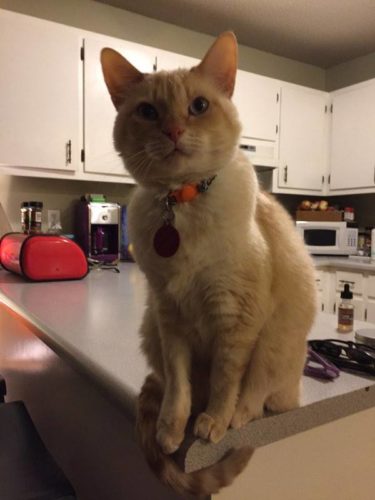 It took about a week of coaxing, watering the food down and fork-feeding but FINALLY he was off the kibble – and so were my other two boys! Carter took a particular liking to the Weruva and Tiki Cat brands, occasionally Nature’s Variety, Ziwipeak and Wild Calling. I then learned about the importance of home-testing, and immediately bought both a pet-specific and human meter. By this time he had been on Vetslin for 2 weeks, with no testing – and even once I started testing, his numbers were still very high in the 400-600 range. I was anxious to get started on getting him to better health, and was now equipped with so much more knowledge regarding home testing, diet changes, how the insulin itself worked throughout the cycle, and how to manipulate the cycle with food. I followed something called “The Tight Regulation Protocol” and learned how to keep Carter in normal numbers longer, and thus by doing so, allowed his pancreas some time to heal.
It took about a week of coaxing, watering the food down and fork-feeding but FINALLY he was off the kibble – and so were my other two boys! Carter took a particular liking to the Weruva and Tiki Cat brands, occasionally Nature’s Variety, Ziwipeak and Wild Calling. I then learned about the importance of home-testing, and immediately bought both a pet-specific and human meter. By this time he had been on Vetslin for 2 weeks, with no testing – and even once I started testing, his numbers were still very high in the 400-600 range. I was anxious to get started on getting him to better health, and was now equipped with so much more knowledge regarding home testing, diet changes, how the insulin itself worked throughout the cycle, and how to manipulate the cycle with food. I followed something called “The Tight Regulation Protocol” and learned how to keep Carter in normal numbers longer, and thus by doing so, allowed his pancreas some time to heal.
It took a couple weeks before I began to see any numbers below 400, and then for a while, he seemed to stay in the 200-400 range consistently. I began to look into the possibility of switching to a raw diet, as what is lower in carbohydrates than pure protein, right? I bought a “Primal” brand starter pack form a holistic pet store, and while my other boys loved it, Carter was hesitant. I tried him on a few other brands, but he still preferred a little canned mixed into it. But hey, better than nothing! I looked into a premade brand called Darwin’s, and to my amazement, he ate it without coaxing, toppers or canned mixed in! Then it happened, roughly 4 months after his diagnoses in March 2016, he hit “the magic dose” of 3 units and started to maintain normal numbers. Thus, he slowly needed less and less insulin, to the point where he was only getting a single drop BID. On the advice of all my new friends in the forum, I started him on an “OTJ” trial, a 14 day trial period with no insulin to see if the cat will remain in normal numbers on their own. He passed his OTJ trial with flying colours, and has been in remission since June 30th, 2016. After months of sleepless nights on the couch, staying up testing his blood sugar when he was going too low, struggling to find a canned then raw diet he would eat, the cost of all the diabetic supplies and insulin, we finally did it! I still test his blood sugar weekly, and he is holding a strong remission.
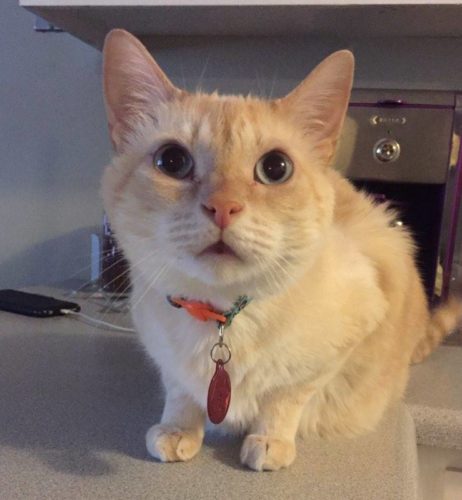 Now, it’s important to remember that a diabetic will ALWAYS be a diabetic – but when they are off insulin, they are strictly diet controlled. I learned the importance of being hyper-vigilant with his diet, as even the smallest amount of “contraband” could potentially put him back on insulin. Not only did a species-appropriate diet save Carter’s life, it saved the lives of my 12 year old cat, my 4 year old cat and my ~ 5 year old dog. All my pets are now raw fed and thriving. Had I not taken the step to advocate for my cat, done my own research and trusted my instincts, there is a real possibility Carter could have died from the complications of diabetes. He has had some digestive issues since reaching remission, to where he has had periods of not being able to stomach raw, so he’s had to have cooked with EZ Complete premix, or freeze-dried, but is doing super! Right now he is on half Primal raw/half Primal freeze-dried. My long-term goal would to have him be on DIY raw, but I’m not going to rock the boat quite yet. He has gone from over 20 pounds when we first got him, to roughly 12 pounds in the past year of his diabetic journey!
Now, it’s important to remember that a diabetic will ALWAYS be a diabetic – but when they are off insulin, they are strictly diet controlled. I learned the importance of being hyper-vigilant with his diet, as even the smallest amount of “contraband” could potentially put him back on insulin. Not only did a species-appropriate diet save Carter’s life, it saved the lives of my 12 year old cat, my 4 year old cat and my ~ 5 year old dog. All my pets are now raw fed and thriving. Had I not taken the step to advocate for my cat, done my own research and trusted my instincts, there is a real possibility Carter could have died from the complications of diabetes. He has had some digestive issues since reaching remission, to where he has had periods of not being able to stomach raw, so he’s had to have cooked with EZ Complete premix, or freeze-dried, but is doing super! Right now he is on half Primal raw/half Primal freeze-dried. My long-term goal would to have him be on DIY raw, but I’m not going to rock the boat quite yet. He has gone from over 20 pounds when we first got him, to roughly 12 pounds in the past year of his diabetic journey!
I am now a huge advocate for raw feeding, especially when it comes to an obligate carnivore like the cat. It has become quite a passion of mine, and in the immediate future I’m looking forward to starting up my raw feeding blog to help educate others on the importance and benefits of this diet. Statistically, most diabetic cats were often kibble fed their whole lives; cats cannot process excessive amounts of carbohydrates in the body, which are then converted to sugar. It’s never too late, and a cat is never too old to eat a healthier diet! I’ve known various owners with cats that have diabetes, CKD, IBD etc that all thrive off a raw diet specifically tailored to their needs.
I often had people ask me “what’s the point” or “why go through all that effort for a cat” or “what’s his quality of life if you’re constantly monitoring everything he does” and my response is to simply show them these photos. THIS is his quality of life now, and this is why I fought for him to get where he is today.
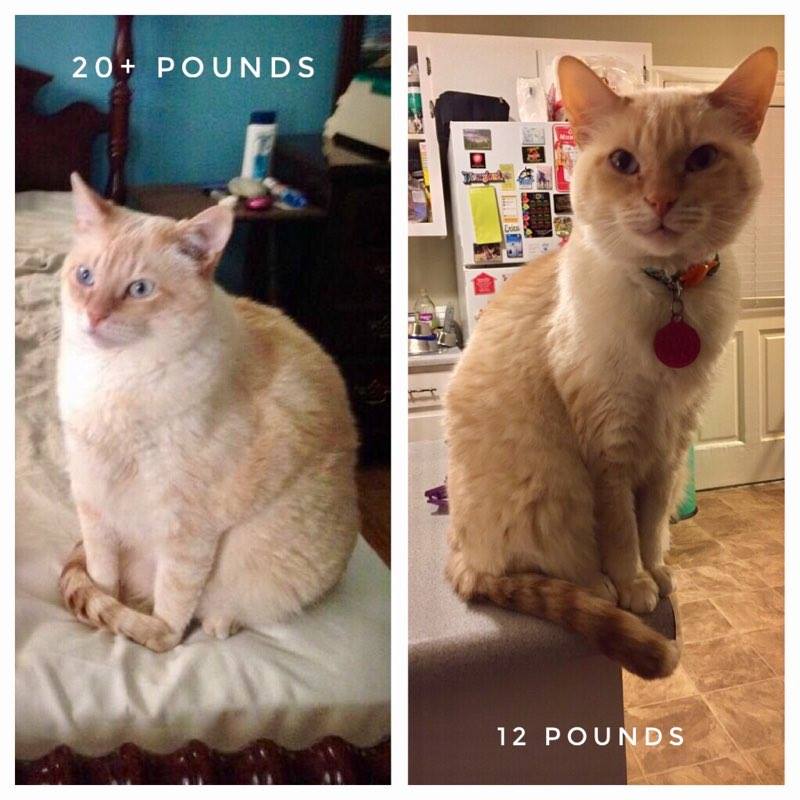
If you feed your kitties a raw diet and would like to see your story featured here, please contact me or leave a comment below.
And if you‘re interested in giving raw a try, check out our Raw Feeding and Transitioning Your Cat to Raw sections, and join the CatCentric group for help and support during your transition.
If you enjoyed this post or found it informative, please “Like” it, “Tweet” it, or share it using any of the buttons below. And don’t forget to check out our FB page, join the discussions in our awesome FB group and follow us on Twitter!


What a handsome boy! And an amazing story too. Kitty was diabetic and I never really questioned giving her insulin … she was down to a normal weight by then … but it makes sense that a body would rebel against food not naturally in one’s diet (ie kibble and not raw).
What a wonderful story and a testimony to what a caring attitude …. And raw … Can do!!! Congrats and hugs to you and Carter and the crew!
He looks so good! <3
Wonderful story. I am going to bookmark this and share with friends. I have fed my 3 cats a raw diet for years,I would never go back! I just found this site- love it.
What a lovely story!! God bless